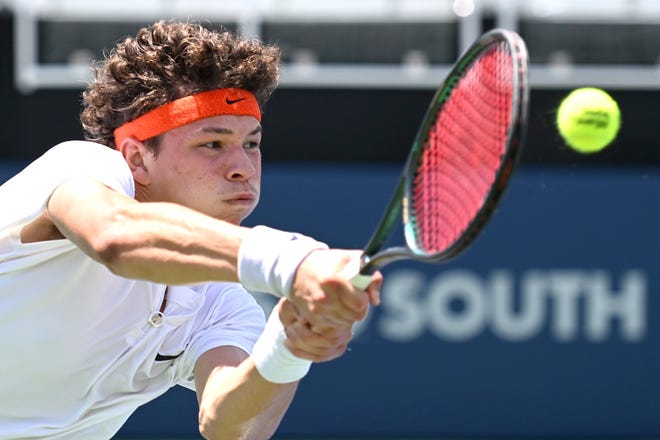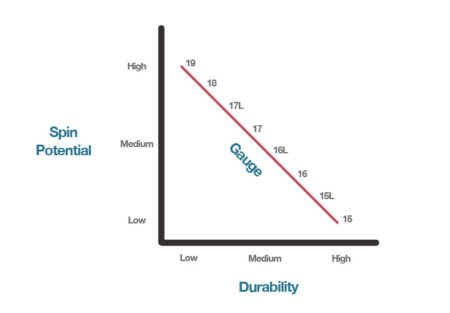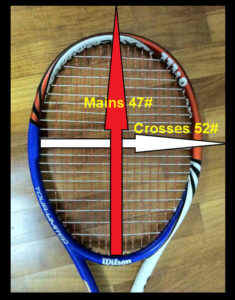NCAA champion Ben Shelton
ATLANTA — The phrase “future of American men’s tennis” mostly inspires groans these days, as 74 Grand Slams have come and gone since Andy Roddick lifted the U.S. Open trophy in 2003.
Invariably, the burden�of that drought falls on the American youngsters who quickly rise up the rankings, start making an impact on the ATP Tour and then run into the Grand Slam wall that Roger Federer, Rafael Nadal and Novak Djokovic have erected over the last two decades.
So let’s not saddle Ben Shelton, just 19, with that kind of albatross. But we can say this: The rising University of Florida junior, who won the NCAA singles title in May, is very, very good. And he’s on the precipice of a career-defining summer that may well put him�on a very different trajectory from the one that seemed laid out for him just a few weeks ago.
Shelton, whose father Bryan is a former top-100 player and now is the head coach at Florida, played his first ATP-level match Tuesday, at the Atlanta Open. He won it in pretty straightforward fashion, beating veteran pro Ramkumar Ramanathan 6-2, 7-5 and letting out a big scream as he put away an overhead on match point.
“It’s really special,” said Shelton, who was just a few blocks from the courts of his childhood at Georgia Tech, where his father coached until 2012.

But with each tournament he’s played, the bigger story is that Shelton himself might be special, and his performance could very well force some decisions about his future much faster than anticipated.
As of now, Shelton is slated to return to Florida in the fall. But after performing well in several Challenger-level events and impressively winning his first round here, he’s on a fast track to the top 200 in the world rankings. Brad Gilbert, the longtime pro player, coach and ESPN analyst, wrote on Twitter that Shelton will be “top 50 for sure.” And the U.S. Open already has granted him a wildcard into the main draw, which would be a guaranteed $75,000 in first-round prize money — if he turns pro.
“That’ll definitely be a talk later in the summer with my parents and my team and we’ll make a decision based on where my development is and what’s going to be best for me not just on the court but off the court as well,” Shelton said. “There’s no real results or rankings that are going to sway my decision in a big way.”
There’s plenty, of course, that could bring Shelton back to college. It’s a comfortable place for him, he wants to complete his finance degree and it’s certainly a big deal to play for his father on one of the most successful teams in the country.
But as he goes through the process this summer, it certainly seems possible Shelton and those around him will conclude that he’s just too good to go back to school.
“I’m just a college guy out here having fun,” he said. “I don’t put too much stress on my matches. I’m focused and want to do the best I can, but it’s not do-or-die for me out here.”
Shelton will get a better sense of where he stands on Thursday when he faces No. 25-ranked John Isner, who has won the Atlanta event six times. After going 11-4 against pros ranked mostly in the 150-300 range, this will be Shelton’s first opportunity to see how he stacks up against a top-100 player.
But regardless of how it goes against Isner — and certainly it’s a major step up in class for someone who hasn’t turned pro yet — it’s Shelton’s explosive game at 6-foot-3 that is drawing as much attention as the results.
With a big lefty serve that averaged 126 mph against Ramanathan and the ability to get a massive kick on his first and second serve, Shelton already has a legitimate weapon that can win him matches. But he also appears to be very solid off both of his groundstrokes and is very comfortable coming into the net to finish points behind both his power and slice. Shelton won 15 of 22 points when he came in for a volley or overhead.
“I love to get to net, be able to use some of my hand skills, athletic skills and going up to get the ball (to put away overheads) is one of my favorite things to do,” Shelton said. “I could have done a better job today incorporating my serve and volley and getting to net quicker in points but I think that’s a big part of my game and a big part of my development.”
Only the hardest of hardcore tennis fans would have been watching Shelton on a Tuesday afternoon in Atlanta, but it was easy to see why he’s been a dominant college player, going 37-5 in singles last season. It was also a huge advertisement for other tournaments this summer and fall to offer him a wildcard entry, as Atlanta did. Every tournament wants to boast that it helped launch a great career.
It’s far too early to project that Tuesday’s match was the debut of the next great American champion, but at the very least Shelton appears poised for an interesting and successful pro career. Shelton may have some things pulling him back to college for another year, but if he keeps playing like he has the last several weeks, it will be difficult to turn down the opportunities he’s creating for himself right now.
Follow USA TODAY Sports columnist Dan Wolken




